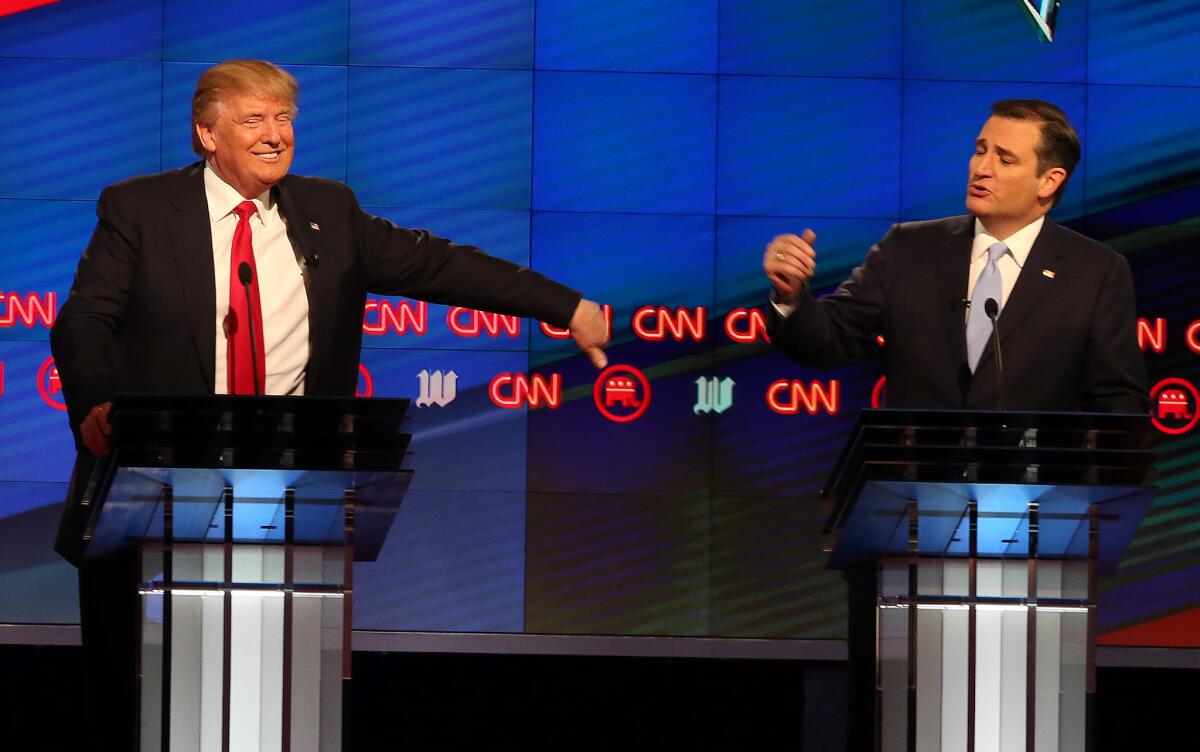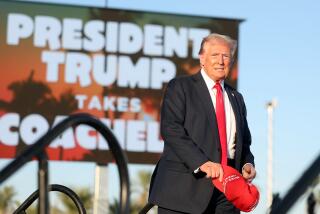Analysis: Bitter GOP divisions are like nothing the party has seen before

Republican presidential candidates Donald Trump and Ted Cruz, seen in a debate earlier this month, lead feuding factions of the party.
Every day there’s a new development in what pollster Randall Gutermuth calls this “hold your nose” presidential election. One day Donald Trump and Ted Cruz are beating each other up over policies; the next day they’re exchanging blows over their wives. The Democrats, for once, seem mild-mannered in comparison, even if a fair number of people don’t like their front-runner, Hillary Clinton, either.
More than seven months remain in a campaign that will no doubt persist with the bloodletting until there’s no blood left to let. And then the work will begin, to try to stitch together a Republican Party that has been riven by division for more than a year.
Election 2016 | Live coverage on Trail Guide | March 22 election results | Track the delegate race | Sign up for the newsletter
The depths of the split in the party came through loudly in a new USC Dornsife/Los Angeles Times poll of California voters. Right now there are two Republican parties here, one inhabited by supporters of Donald Trump, and the other inhabited by supporters of everyone else. The Trump people don’t like the other candidates. People supporting the other candidates don’t like Trump.
This seems to go beyond the usual primary season divisions seen in past Republican races and in the current Democratic contest. Usually, candidates in a party battle fiercely to the end, pout for a while, then come back together in November.
A template: the extended feud in 2008 between Hillary Clinton and Barack Obama. He scalded her as “likable enough” and criticized her vote for the Iraq war. She condemned his healthcare policy and said he wasn’t fit to answer the 3 a.m. emergency phone call in the White House.
When it was over, many of her loyalists vowed never to support him. But the two met at the Washington home of California’s senior senator, Dianne Feinstein, and soon thereafter were praising each other at a televised event in fetchingly named Unity, N.H., her light blue pantsuit the same color as his tie.
She worked on her supporters; most of them came around for a resounding Democratic victory in the general election. She joined his administration as secretary of State and now cites her service to him as a big rationale for her election this cycle.
It’s hard to imagine that happening with this year’s Republicans. More than three in 10 of Texas Sen. Ted Cruz’s California supporters said they will not vote for Donald Trump if he is the November nominee. Almost the same proportion of California Republicans overall said they wouldn’t vote for him. Trump’s fans return the favor; half of them had an unfavorable impression of Cruz.
Such discontent can ease, but that process is smoother if trouble hasn’t been brewing for an awfully long time. And the Republican split has been at a threatening burn for so long that an explosion was nearly inevitable.
For several election cycles, the party has had visible splits, but the establishment maintained the upper hand, in part because its candidates were the best-financed and organized. Things began to get dicier when, to build the party up in the face of Democratic gains among younger and minority voters, many Republican candidates began escalating their claims of what the party would accomplish if only everyone jumped aboard the train.
Demonizing Democrats (and Democrats did their own demonizing, to be sure) raised election stakes to the point of existential threats. Promising to eradicate Obamacare when Obama remained the president fed the dreams of many voters, and, when it proved predictably impossible to pull off, fed their frustration.
Anger — and real fear — over an economic recovery that had passed them by, and of an immigration system that they saw as flouting the law without any reaction from Washington, fed the frustration further.
This year, many of them had their revenge in the unorthodox candidacy of a New York billionaire turned reality television star.
Join the conversation on Facebook >>
In interview after interview at Trump events around the country, voters asked why they’d gravitated to him answered with the same word: change.
“We are in a desperate need for change ... and he’s not afraid to make that change,” said Sue Sescourka, a Trump supporter who attended his rally two weeks ago at the Youngstown, Ohio, airport.
The Trump voters have become a singular lot, nationally and in California. The USC Dornsife/Los Angeles Times poll showed they are far more energized by the subject of illegal immigration and far more negative about the country’s economy and future. They are also passionate about their candidate in a way that allows him to say almost anything without losing his grip on them.
Their support hasn’t ebbed even with the recent controversy over remarks he made that condoned violence and the subsequent violent treatment of protesters at his campaign events.
When the pollsters asked who was to blame for violence at Trump rallies, 22% of Californians overall cited the protesters, 54% pointed to Trump and 19% said the media had blown the events out of proportion. Among Republicans, 44% blamed the protesters, 23% blamed Trump and 27% blamed the media.
Asked whether Trump should continue to speak out or tone down his rhetoric, 65% of Californians said he should tone it down. Among Republicans, 44% said he should tone it down.
Not so the Trump voters: Only 19% said he should tone it down, and 76% said he should keep saying what he wants to say.
Right now, in California and nationally, those voters make up more than a third of the GOP electorate. And the gap the party will somehow have to fill after November seems to grow wider every day.
Follow me on Twitter: @cathleendecker. For more on politics, go to latimes.com/decker.
ALSO:
Trump leads in primary but threatens a GOP fracture
Why winning California’s primary won’t be easy for Bernie Sanders
California’s June primary just became crucial in the race for the White House
Full coverage of the USC Dornsife/Los Angeles Times poll
Updates on California politics
Live coverage from the campaign trail
More to Read
Get the L.A. Times Politics newsletter
Deeply reported insights into legislation, politics and policy from Sacramento, Washington and beyond. In your inbox three times per week.
You may occasionally receive promotional content from the Los Angeles Times.











